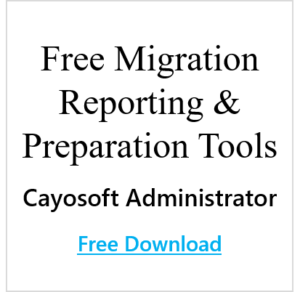Office 365 Migration Planning Tasks:
- Office 365 Migration Planning – Create the Plan
▪ Seven reports you should include:
▪ Users with Invalid Data
▪ Mailboxes and Sizes
▪ Shared Mailboxes and Sizes
▪ Distribution Groups and Membership Count
▪ Mailbox Security Assignments
▪ Mailboxes with Large Attachments
▪ Active Directory Users by Department/location - Identify VIP Accounts
- Set Migration Sequence
- Identify Speed/Bandwidth Constraints
- Identify the Final Hybrid State
- Plan to Mitigate Higher IT Workload from Hybrid
Office 365 Migration Plan
Well thought out Office 365 Migration Planning can be the difference between a successful move to Office 365 and one that is fraught with problems. Small organizations may choose to move all mailboxes in one move. Larger organizations will likely choose to divide the migration by department, location, a combination of both or by other determining factors. Making exceptions for moving VIP mailboxes may also need to be part of the overall Migration Plan.
Identify VIP Accounts/Mailboxes
Some users in your environment may be more sensitive to disruption in your environment than others. Identify these accounts early-on and plan on dealing with them with special consideration. For example, the CEO’s mailbox may need to be migrated last so that any problems that are resolved early will not affect this very important user.
Set the Migration Sequence
If you have few mailboxes, you can probably move them all at once. As the number of mailboxes increases consider breaking the mailboxes into smaller migration batches. This reduces the risk from error and it also allows better control and visibility over synchronization of mailbox content. Many migrations are done by breaking down the list of mailboxes by Department, location or both. The first step will be to create an inventory of active users, mailboxes, resource mailboxes and distribution groups you will want to move to Office 365. There are free reporting tools that will make it easy to perform this assessment. For user and resource mailboxes, you will want a report that details the size of each mailbox so you have a keen understanding of the amount of data that will be moved online.
Identify Speed/Bandwidth Constraints
There are a number of factors that determine how much mail you can migrate over a given period of time.
Identify the Final Hybrid State
Active Directory + Exchange On-Premises Hybrid – If you will have on-premises mailboxes or if mail MX records deliver mail on-premises first then route messages to Exchange online; you will continuing with Exchange Hybrid.
Active Directory Only Hybrid – If you will no longer have on-premises mailboxes and mail MX records deliver mail to Exchange Online only; you can remove Exchange on-premises and operate in Active Directory Only Hybrid Mode.
Can I remove my last Exchange Server?
Plan for Increased Burden on IT
One of the hidden costs of moving to Office 365 is the added burden that Hybrid Administration places on IT. Often tasks that could easily be performed by the help desk are suddenly directed toward Sr. Administrators or go unattended for longer periods of time. There are options for dealing with the added hybrid burden and ideally, your mailboxes should be migrated into a well managed Hybrid AD/Office 365 tenant.
Other Things to Consider
- Review the Office 365 Exchange Online limitations here.
- How will new users be on-boarded during the migration?
- Should you engage a partner?
